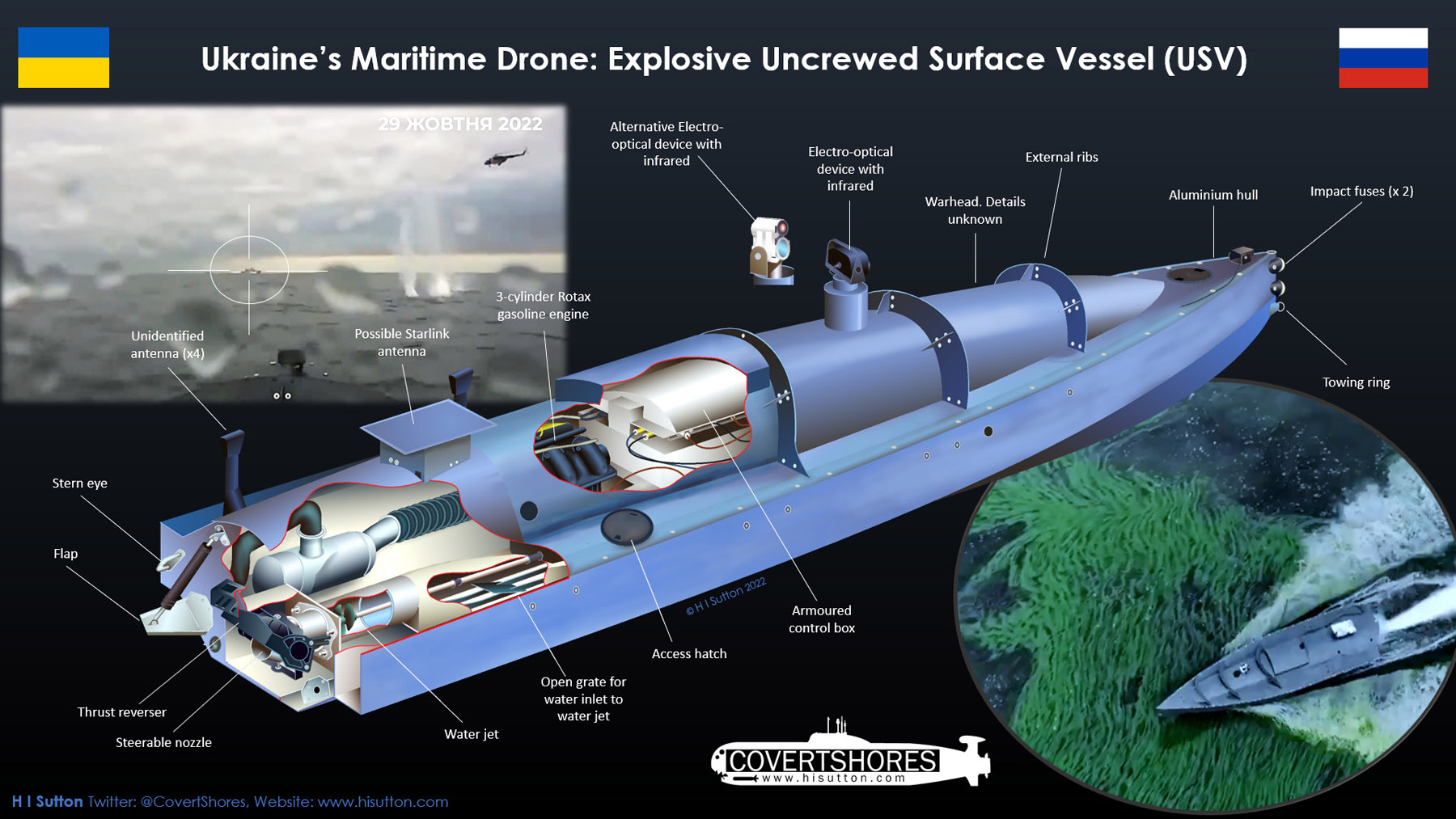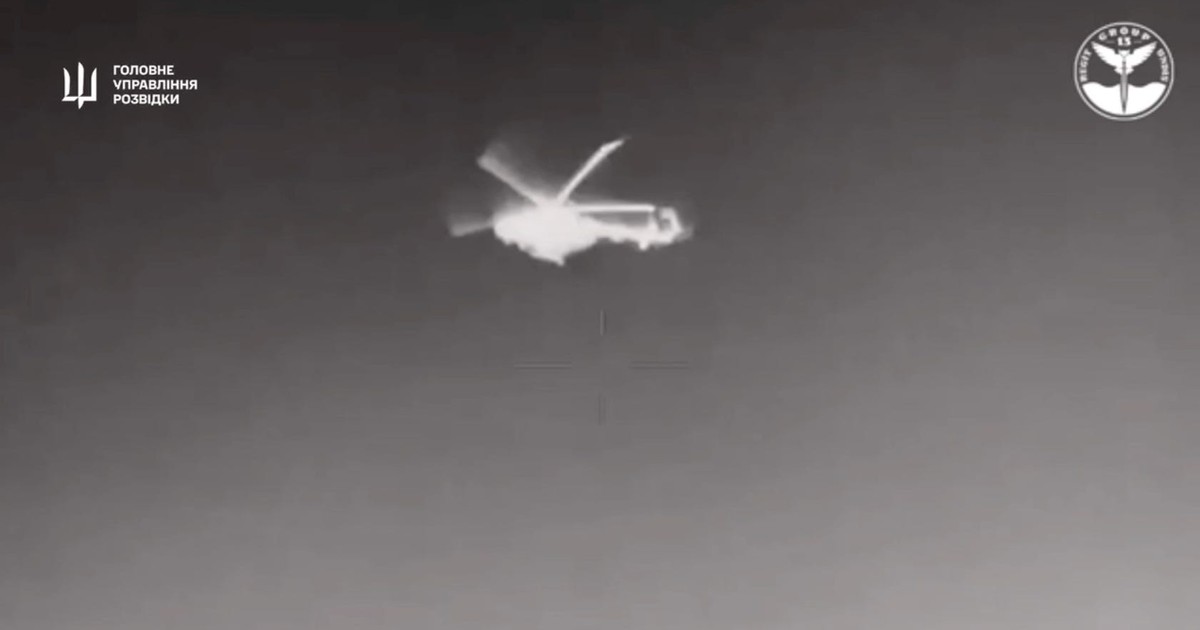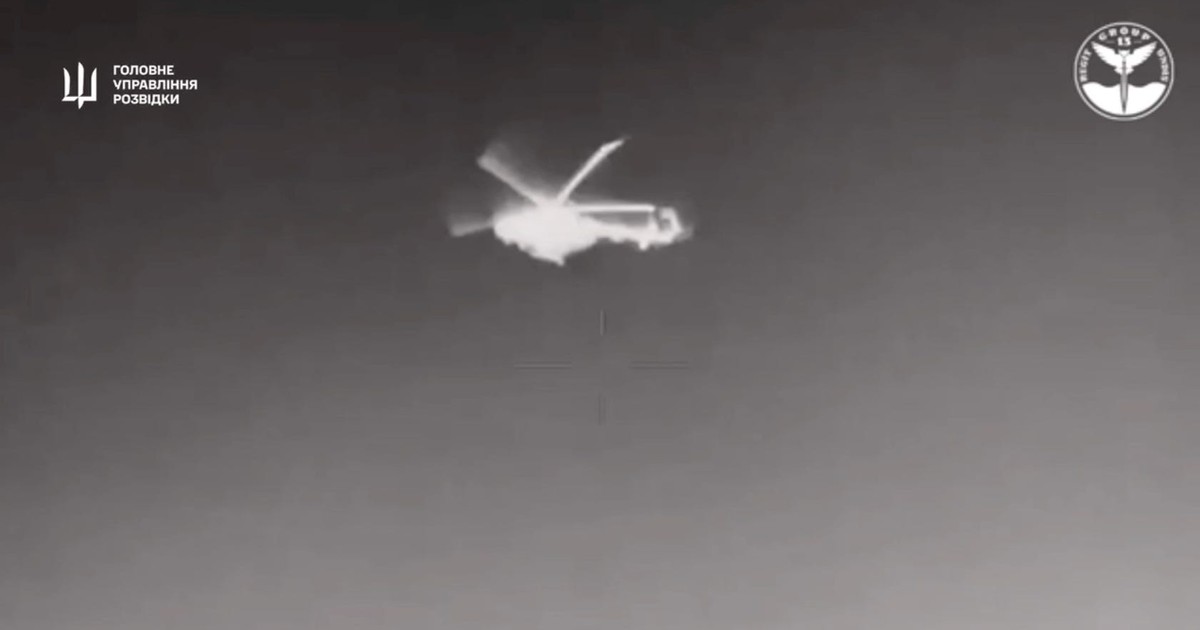Ukrainian sea drones are changing the face of naval warfare. These unmanned vessels, packed with cutting-edge technology, offer a cost-effective and adaptable approach to maritime defense and offense. From their design and deployment to their strategic implications and future potential, the story of Ukrainian sea drones is a fascinating blend of innovation and real-world impact.
This exploration will delve into the various types of Ukrainian sea drones, examining their capabilities, operational strategies, and the technological advancements that make them so effective. We’ll also consider the broader geopolitical and economic implications of this rapidly evolving technology, exploring both its advantages and potential vulnerabilities.
Ukrainian Sea Drones: A Technological Deep Dive

Ukraine’s innovative use of sea drones in the ongoing conflict has significantly altered the landscape of naval warfare. These unmanned vessels, relatively inexpensive and easily deployable, present a potent asymmetric warfare capability. This article explores the technological aspects, operational capabilities, impact, and future potential of these game-changing platforms.
Ukraine’s naval capabilities are getting a serious upgrade thanks to their innovative sea drone program. These unmanned vessels are proving surprisingly effective, and you can learn more about the specifics of their design and deployment by checking out this informative resource on ukrainian sea drone technology. Understanding these drones is key to grasping the evolving dynamics of the conflict and the ingenuity of Ukrainian defense strategies.
The future of naval warfare might just depend on advancements like these Ukrainian sea drones.
Types and Functionalities of Ukrainian Sea Drones
Ukraine employs a variety of sea drones, ranging from smaller, simpler models for reconnaissance and surveillance to larger, more sophisticated drones capable of carrying heavier payloads and engaging in offensive operations. While specific details remain classified, reports suggest a diverse fleet, potentially including both surface and underwater drones, each tailored for different missions.
Technological Advancements in Ukrainian Sea Drones
These drones incorporate several key technological advancements. Propulsion systems likely range from electric motors for quieter operation to more powerful internal combustion engines for greater speed and range. Navigation systems likely utilize GPS, inertial navigation systems (INS), and potentially even more advanced systems like satellite-aided navigation. Payload delivery mechanisms are adapted to the specific mission, ranging from simple explosive charges to sophisticated warheads or even the ability to deploy smaller, secondary drones.
Comparison with Other Nations’ Sea Drone Technology

Compared to other nations, Ukraine’s sea drone technology demonstrates a remarkable level of sophistication considering the resources available. While lacking the advanced AI and autonomy of some Western systems, Ukrainian drones showcase ingenuity in adapting readily available components and integrating them effectively for a cost-effective, impactful outcome. The emphasis is on practical application and adaptability to the current conflict needs.
Materials and Performance
The materials used in construction likely prioritize affordability and availability. Composites, readily available metals, and potentially even repurposed materials are likely employed. This pragmatic approach emphasizes cost-effectiveness over the use of high-end, specialized materials found in more expensive systems. The impact on performance is balanced against the overall cost-benefit analysis.
Comparison of Ukrainian Sea Drone Models
| Model | Speed (knots) | Range (km) | Payload Capacity (kg) | Primary Function |
|---|---|---|---|---|
| Model A (Hypothetical) | 15-20 | 50-100 | 50-100 | Reconnaissance & Surveillance |
| Model B (Hypothetical) | 25-30 | 150-200 | 150-250 | Offensive Operations |
| Model C (Hypothetical) | 5-10 | 20-50 | 20-50 | Underwater Reconnaissance |
| Model D (Hypothetical) | 10-15 | 100-150 | 100-150 | Mine Laying |
Operational Capabilities and Deployment of Ukrainian Sea Drones
Deployment methods are likely diverse and adaptable to the operational environment. They could involve launching from larger vessels, shore-based platforms, or even from smaller, concealed locations. The strategic advantages include cost-effectiveness, the ability to overwhelm defenses with swarms, and the element of surprise. Disadvantages include vulnerability to countermeasures, limited endurance, and reliance on reliable communication links.
Deployment Methods and Strategic Advantages
The strategic advantages of using sea drones in maritime warfare are numerous. Their low cost allows for large-scale deployments, overwhelming enemy defenses through sheer numbers. Their small size and relative quietness allow for covert operations and surprise attacks. Their versatility allows them to be adapted to a wide range of missions, from reconnaissance to offensive attacks.
Ukrainian sea drones are proving surprisingly effective in naval warfare, showcasing the adaptability of unmanned technology. Think about the sheer scale and precision involved, a stark contrast to the smaller, more targeted applications – like you see in the amazing light shows at the shanghai drone show. The coordinated movements in both scenarios highlight the potential of drone technology, though their applications are vastly different; from disrupting naval fleets to creating breathtaking aerial displays, drones are changing the game.
Vulnerabilities and Countermeasures
Potential vulnerabilities include susceptibility to electronic warfare (EW), detection by radar or sonar, and physical damage from enemy fire. Countermeasures could include the use of electronic countermeasures (ECM), stealth technologies, and swarm tactics to overwhelm defenses. The development of advanced evasion and counter-detection technologies is crucial.
Successful Deployments and Impact
Reports of successful deployments of Ukrainian sea drones against Russian naval targets have highlighted their effectiveness. While specific details remain limited for operational security reasons, these operations demonstrate the potential of low-cost, asymmetric warfare capabilities to inflict significant damage on larger, more expensive naval assets. The psychological impact on enemy morale is also a significant factor.
Steps in a Typical Sea Drone Mission
- Mission Planning and Preparation
- Drone Launch and Deployment
- Navigation and Target Acquisition
- Payload Delivery or Data Collection
- Data Transmission and Analysis
- Drone Recovery or Disposal
Impact and Implications of Ukrainian Sea Drones
The impact of Ukrainian sea drones on naval warfare is profound. They demonstrate the potential for smaller nations or non-state actors to challenge the dominance of larger naval powers. This necessitates a reevaluation of naval strategies and defense systems.
Ukrainian sea drones are proving surprisingly effective in naval warfare, showcasing innovative tactics. Thinking about the desperation behind such military innovations makes you wonder about the real-life struggles that inspired shows like squid game histoire vraie , highlighting the harsh realities that can drive people to extreme measures. The development and deployment of these drones are a testament to Ukraine’s resourcefulness in the face of conflict.
Impact on Naval Warfare
The use of sea drones has fundamentally shifted the dynamics of naval warfare. Their cost-effectiveness and ease of deployment allow for a new level of asymmetric warfare capabilities, challenging traditional naval dominance. The potential for swarm attacks, in particular, necessitates a rethinking of naval defense strategies.
Geopolitical Implications
The widespread adoption of sea drone technology could lead to a significant shift in the global balance of power. Smaller nations and non-state actors may gain a significant advantage, potentially destabilizing existing power structures. International regulations and arms control agreements will need to adapt to this new reality.
Economic Considerations
The relatively low cost of production and maintenance of sea drones compared to traditional naval vessels makes them an attractive option for many nations. This cost-effectiveness, however, must be balanced against the potential costs of research, development, and ongoing technological upgrades. The economic impact extends to the creation of new industries and job opportunities.
Cost-Effectiveness vs. Traditional Naval Vessels

In many scenarios, sea drones offer superior cost-effectiveness compared to traditional naval vessels. Their low cost allows for larger-scale deployments and the ability to saturate enemy defenses, achieving a similar or greater impact at a fraction of the cost. However, the limitations in endurance and payload capacity need to be considered.
Ethical Implications
The use of autonomous sea drones in combat raises significant ethical concerns. The lack of human control over lethal force decisions requires careful consideration of accountability, potential for unintended harm, and the overall implications for the laws of war. International discussions and agreements are crucial to establish clear guidelines and regulations.
Future Developments and Predictions for Ukrainian Sea Drone Technology
Future advancements in Ukrainian sea drone technology are likely to focus on increased autonomy, improved payload capacity, enhanced stealth capabilities, and better integration of AI and machine learning.
Potential Advancements in Technology
We can anticipate advancements in areas such as improved propulsion systems, more sophisticated navigation and targeting systems, and the integration of AI for enhanced autonomy and decision-making. The use of swarm tactics and improved communication systems will also likely be key areas of focus. Increased range and endurance are also highly probable.
AI and Machine Learning Integration
The integration of AI and machine learning will dramatically enhance the capabilities of sea drones. AI-powered systems could improve target recognition, autonomous navigation, and decision-making in dynamic environments. Machine learning algorithms can analyze vast amounts of data to optimize mission planning and execution.
Expansion of Capabilities
Future sea drones could possess significantly increased autonomy, allowing them to operate independently for extended periods without human intervention. Payload capacity could be increased, enabling the deployment of larger and more powerful weapons or sensors. Stealth technologies could also be improved, making them harder to detect and track.
Hypothetical Scenario of Advanced Sea Drone Use
In a future conflict, a swarm of advanced Ukrainian sea drones, equipped with AI-powered targeting systems and enhanced stealth capabilities, could launch a coordinated attack against a larger enemy fleet. The drones’ ability to evade detection and inflict significant damage would significantly alter the balance of power.
Timeline of Future Evolution, Ukrainian sea drone
Over the next decade, we can anticipate a rapid evolution of Ukrainian sea drone technology. Within the next 5 years, expect significant improvements in AI integration and autonomy. Within 10 years, the integration of advanced swarm tactics and enhanced payload capabilities are highly probable, potentially including the deployment of hypersonic weapons. The development of more sophisticated underwater drones is also a strong possibility.
Illustrative Examples of Ukrainian Sea Drones
Visual Representation of a Ukrainian Sea Drone
Imagine a sleek, roughly 5-meter long, unmanned surface vessel, shaped somewhat like a torpedo boat but with a flatter deck. The hull is constructed from a dark grey composite material, designed for stealth. A small, centrally located antenna protrudes, suggesting a sophisticated communication and navigation system. At the rear, a powerful waterjet propulsion system is visible, allowing for relatively high speeds.
A small, unobtrusive compartment on the deck houses the payload, potentially a variety of explosives or sensors, depending on the mission.
Hypothetical Sea Drone Attack
Under the cover of darkness, a swarm of these drones approaches an enemy naval base. Utilizing advanced AI-powered navigation, they evade detection by sonar and radar. Upon reaching their target, they unleash a coordinated barrage of attacks, utilizing both kinetic and potentially non-kinetic weapons. The resulting chaos and damage disrupt enemy operations and inflict significant losses.
Manufacturing Process of a Drone Component
Consider the manufacturing of the drone’s propulsion system. The process begins with the design and creation of 3D-printed molds for the various components. These molds are then used to create the waterjet pump housing from high-strength, lightweight composite materials. Precision machining and assembly are used to integrate the pump, motor, and other components. Rigorous testing and quality control measures ensure the system’s reliability and performance under challenging conditions.
Conclusion
Ukrainian sea drones represent a significant shift in naval power dynamics. Their relatively low cost, adaptability, and potential for autonomous operation offer a compelling alternative to traditional naval vessels. While challenges remain regarding their vulnerabilities and ethical considerations, the future of Ukrainian sea drone technology appears bright, promising further advancements in autonomy, payload capacity, and overall effectiveness. Their impact on future conflicts and the broader geopolitical landscape is undeniable and warrants continued observation.
Helpful Answers: Ukrainian Sea Drone
How are Ukrainian sea drones powered?
Power sources vary depending on the drone model, but common options include electric motors powered by batteries, or internal combustion engines.
What is the range of a typical Ukrainian sea drone?
Range varies significantly by model, but some can operate for hundreds of kilometers.
What types of payloads can Ukrainian sea drones carry?
Payloads can include explosives, sensors, cameras, and communication equipment.
Are Ukrainian sea drones fully autonomous?
While some level of autonomy is present, many models require human oversight and control, at least for certain mission phases.
